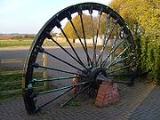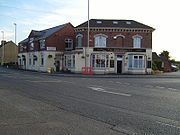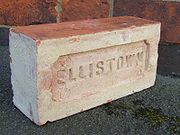
Ellistown
Encyclopedia
Ellistown is a small village in Leicestershire
, England
with a primary school, 5 play parks, a football club
,two shops, a garage
, a [Cadbury] shop, a Post Office
and a hairdressers. There is also a Public house
with rooms to rent, called The New Ellistown (a pub), and a Working Men's Club. It is situated on the main village crossroads which recently became two mini round-a-bouts. The village lies 2 miles (3 km) from the larger village of Ibstock
, and 1½ miles (2½ km) from the town of Coalville
. Ellistown lies just within the western boundaries of the National Forest
. It is in the North-west Leicestershire District and civil parish of Ellistown and Battleflat
and after the Reformation in the Diocese of Peterborough (from 1926 in that of Leicester). The town was used for coal mines during the Victorian period.
.
When the dissolution of the monasteries (by King Henry VIII) occurred their lands were seized and rented out. Swinfen Grange was rented to a John Pykeringe in 1531 for £7 per year. At this point the name seems to have changed to Pykeringe Grange after its first lay tenant, although there is some evidence to show that Swinfen Grange and Pykeringe Grange seemed to coexist for some time together. The area that became Ellistown initially was known as Swinfen Rushes at the start of the 19th century, while that now named “Pickering Grange” seemed to extend to the crossroads where the Hugglescote
to Bagworth
pony track crossed Beverley’s Lane. The manorial history is shown in detail in John Nichols's History of the County of Leicester, vol. IV and by Curtis 30 years later
, to avoid the toll roads, and then on to Leicester via Aylestone
. The Slip Inn on Whitehill Road near where the first pit was sunk was a favoured stopping point for the pony trains. John Curtis in his account of the county in 1831 mentions Pickering's Grange as a hamlet in the parish of Ibstock.
On their arrival the Ellises took over the Inn converting it into their servants quarters and adding accommodation for themselves as well as stables and a carriage house. Around there was very little in the way of buildings at this time, Johnny Battram
’s cottage, a couple of farms along Whitehill Lane and the railway spur that served the Ibstock Colliery.
 The Ellistown Colliery was sunk in 1873 and two years later was producing coal. The colliery had rail links onto the Leicester to Burton Railway. Colonel Ellis had two terraces of houses erected on either side of the Bagworth to Hugglescote road to accommodate employees and this was the beginnings of modern Ellistown. All, but one, of these terraces have now gone. Towards the end of their lives Ellistown West Terraces had a great deal of iron banding and brick supports attached to them to stop any of the effect of mining subsidence that is prevalent in this area.
The Ellistown Colliery was sunk in 1873 and two years later was producing coal. The colliery had rail links onto the Leicester to Burton Railway. Colonel Ellis had two terraces of houses erected on either side of the Bagworth to Hugglescote road to accommodate employees and this was the beginnings of modern Ellistown. All, but one, of these terraces have now gone. Towards the end of their lives Ellistown West Terraces had a great deal of iron banding and brick supports attached to them to stop any of the effect of mining subsidence that is prevalent in this area.
The South Leicestershire Coal Company opened its colliery in 1874 northeast of the crossroads. Like Ellis it built terraces for its workers on the lane leading to it, South Street. The colliery had rail links onto the Ashby and Nuneaton Joint Railway (See the Battlefield Line Railway
). With the closure of the railway in 1964 the railway trackbed was realigned; from running through the old Hugglescote Station to having the embankment north of it removed and rebuilt to run into the South Leicestershire Colliery only.
built a day school which also served as a mission church. The Church of England parish church
of Saint Christopher
was built in 1895 out of local brick.
At the same time the Methodists were building a chapel by the original Ellistown Terraces and the Wesleyans built theirs opposite what came to be known as White Hill Farm. Both of these chapels have since been demolished, the Wesleyan Chapel was replaced by newer housing.
 The pub currently known as the New Ellistown was initially named the South Leicester Hotel and stands on the land of the original White Hill Farm. Deeds for White Hill Farm date back to 1784 showing the farm's location running from the crossroads along Ibstock Road to the end of the present day village.
The pub currently known as the New Ellistown was initially named the South Leicester Hotel and stands on the land of the original White Hill Farm. Deeds for White Hill Farm date back to 1784 showing the farm's location running from the crossroads along Ibstock Road to the end of the present day village.
The first private houses on White Hill Road appeared in 1877: both pits prospered and more housing was required so the Ibstock and Midland Roads were developed. The terraces on Kendal and Cumberland Roads were erected 1895-1900. Once the development of White Hill Road had happened the two separate areas of White Hill and Ellistown became one, and this was called Ellistown.
 St Christopher’s Church foundation stone was laid in October 1895 by Mrs Mandell-Creighton, the Bishop of Peterborough
St Christopher’s Church foundation stone was laid in October 1895 by Mrs Mandell-Creighton, the Bishop of Peterborough
’s wife. It was consecrated on 25 April 1896 by the Bishop. It was constructed using Ellistown Red Tapped bricks from the Ellistown Brick and Pipe Company. The Rev. Mr. Terry became the first vicar of the Parish. In 1911 a vicarage was erected next to the church for the Rev. Mr. Boothby: before this Broughton Villa on Whitehill Road served as the vicarage.
 In 1897 Colonel Ellis died, the colliery, brickworks and estate being carried on by trustees under Orders of the Court of Chancery until 1936. In 1936 the colliery and brickworks were separated into two separate companies. Ellistown Brick and Pipe Company closed before the Second World War. N. B. Colonel Ellis was not a member of the prominent Ellis family of Leicester though there has been confusion about this.
In 1897 Colonel Ellis died, the colliery, brickworks and estate being carried on by trustees under Orders of the Court of Chancery until 1936. In 1936 the colliery and brickworks were separated into two separate companies. Ellistown Brick and Pipe Company closed before the Second World War. N. B. Colonel Ellis was not a member of the prominent Ellis family of Leicester though there has been confusion about this.
Most collieries in Britain were nationalised in 1947. On 16 May 1952 a notice of a meeting for the winding up of the Ellistown Colliery Company Limited was published. The site is now a concrete pipe manufacturing facility. The South Leicestershire Colliery closed in 1989, the site of the colliery is now a small industrial estate.
The main church in the village is St Christopher's churh. The Rev'd Olwen Woolcock, and curate, Rev'd Rhona Passey, are the leaders of all the parish churches in this area.
Over the last few years Ellistown has expanded dramatically with the addition of new housing estates on its eastern side. Recently, Ellistown council has introduced a gala day, which takes place every August on South Street park.
In July- August 2010, one of Ellistowns most used parks, was revamped - making it more suitible for older children. As well as still having equipment for youger children and a large football field.
Leicestershire
Leicestershire is a landlocked county in the English Midlands. It takes its name from the heavily populated City of Leicester, traditionally its administrative centre, although the City of Leicester unitary authority is today administered separately from the rest of Leicestershire...
, England
England
England is a country that is part of the United Kingdom. It shares land borders with Scotland to the north and Wales to the west; the Irish Sea is to the north west, the Celtic Sea to the south west, with the North Sea to the east and the English Channel to the south separating it from continental...
with a primary school, 5 play parks, a football club
Ellistown F.C.
Ellistown F.C. are a football club based in Ellistown, near Coalville, Leicestershire, England. They currently play in the East Midlands Counties League, having joined from the Leicestershire Senior League at the end of the 2007-08 season....
,two shops, a garage
Filling station
A filling station, also known as a fueling station, garage, gasbar , gas station , petrol bunk , petrol pump , petrol garage, petrol kiosk , petrol station "'servo"' in Australia or service station, is a facility which sells fuel and lubricants...
, a [Cadbury] shop, a Post Office
Post office
A post office is a facility forming part of a postal system for the posting, receipt, sorting, handling, transmission or delivery of mail.Post offices offer mail-related services such as post office boxes, postage and packaging supplies...
and a hairdressers. There is also a Public house
Public house
A public house, informally known as a pub, is a drinking establishment fundamental to the culture of Britain, Ireland, Australia and New Zealand. There are approximately 53,500 public houses in the United Kingdom. This number has been declining every year, so that nearly half of the smaller...
with rooms to rent, called The New Ellistown (a pub), and a Working Men's Club. It is situated on the main village crossroads which recently became two mini round-a-bouts. The village lies 2 miles (3 km) from the larger village of Ibstock
Ibstock
Ibstock is a village and civil parish about south of Coalville in North West Leicestershire, England. The village is on the A447 road Between Coalville and Hinckley....
, and 1½ miles (2½ km) from the town of Coalville
Coalville
Coalville is a town in North West Leicestershire, England, with a population estimated in 2003 to be almost 33,000. It is situated on the A511 trunk road between Leicester and Burton upon Trent, close to junction 22 of the M1 motorway where the A511 meets the A50 between Ashby-de-la-Zouch and...
. Ellistown lies just within the western boundaries of the National Forest
National Forest, England
The National Forest is one of England’s most ambitious environmental projects. Across parts of Leicestershire, Derbyshire and Staffordshire, are being transformed, blending ancient woodland with new planting to create a new national forest...
. It is in the North-west Leicestershire District and civil parish of Ellistown and Battleflat
Ellistown and Battleflat
Ellistown and Battleflat is a civil parish in North West Leicestershire, Leicestershire, England, just south of the unparished area of Coalville. As its name indicates, the parish includes the villages of Ellistown and Battleflat...
History
Ellistown received its name from Colonel Joseph Joel Ellis of London. However the history of Ellistown predates Colonel Ellis. From the 14th century it was in the hundred of Sparkenhoe and parish of IbstockIbstock
Ibstock is a village and civil parish about south of Coalville in North West Leicestershire, England. The village is on the A447 road Between Coalville and Hinckley....
and after the Reformation in the Diocese of Peterborough (from 1926 in that of Leicester). The town was used for coal mines during the Victorian period.
Mediaeval and early Modern Periods
Around 1140 Swinfen Grange was one of two granges given by nobleman Robert Byrton to the Abbot of Garendon Abbey which was based near what is modern day Shepshed. Swinfen was where the Abbot's bailiff resided and was only a small mud and wattle built settlement with three strip fields surrounded by the Charnwood ForestCharnwood Forest
Charnwood Forest is an upland tract in north-western Leicestershire, England, bounded by Leicester, Loughborough, and Coalville. The area is undulating, rocky and picturesque, with barren areas. It also has some extensive tracts of woodland; its elevation is generally 600 ft and upwards, the area...
.
When the dissolution of the monasteries (by King Henry VIII) occurred their lands were seized and rented out. Swinfen Grange was rented to a John Pykeringe in 1531 for £7 per year. At this point the name seems to have changed to Pykeringe Grange after its first lay tenant, although there is some evidence to show that Swinfen Grange and Pykeringe Grange seemed to coexist for some time together. The area that became Ellistown initially was known as Swinfen Rushes at the start of the 19th century, while that now named “Pickering Grange” seemed to extend to the crossroads where the Hugglescote
Hugglescote
Hugglescote is a village in North West Leicestershire, England. It formerly formed a civil parish with the adjacent settlement of Donington le Heath, though this was dissolved in 1936, when the area joined the urban district of Coalville...
to Bagworth
Bagworth
Bagworth is a village in Leicestershire, England, west of Leicester.-History:There are records of the manor of Bagworth from the early 14th and early 15th centuries, when it was held by the same feudal lords as the neighbouring manor of Thornton....
pony track crossed Beverley’s Lane. The manorial history is shown in detail in John Nichols's History of the County of Leicester, vol. IV and by Curtis 30 years later
The Nineteenth Century -- to 1880
The pony trains appear to have demised around 1810 with the coming of the canals and railways in the area. The pony trains extensively brought coal from the Ibstock Colliery and turning at the crossroads towards BagworthBagworth and Ellistown railway station
Bagworth and Ellistown was a railway station on the Leicester to Burton upon Trent Line, that served the villages of Bagworth and Ellistown in Leicestershire. It was opened by the Midland Railway in 1849 and closed by British Railways in 1964. It was at Bagworth on what is now the B585...
, to avoid the toll roads, and then on to Leicester via Aylestone
Aylestone
Aylestone is a suburb of Leicester, England at . It is south-west of the city centre, but to the east of the River Soar.It was formerly a separate village, but the growth of the city has meant that it is now part of the urban area, largely surrounded by 20th century housing. However, the area...
. The Slip Inn on Whitehill Road near where the first pit was sunk was a favoured stopping point for the pony trains. John Curtis in his account of the county in 1831 mentions Pickering's Grange as a hamlet in the parish of Ibstock.
On their arrival the Ellises took over the Inn converting it into their servants quarters and adding accommodation for themselves as well as stables and a carriage house. Around there was very little in the way of buildings at this time, Johnny Battram
Battram
Battram is a hamlet forming part of the Ibstock civil parish in North West Leicestershire, England.Battram is named after Johnny Battram, who had the original cottage, but very much expanded with the coming of coal mining in the area. The village was in the shadow of Nailstone pit and not far from...
’s cottage, a couple of farms along Whitehill Lane and the railway spur that served the Ibstock Colliery.

The South Leicestershire Coal Company opened its colliery in 1874 northeast of the crossroads. Like Ellis it built terraces for its workers on the lane leading to it, South Street. The colliery had rail links onto the Ashby and Nuneaton Joint Railway (See the Battlefield Line Railway
Battlefield Line Railway
The Battlefield Line Railway is a heritage railway in Leicestershire, England. It runs from Shackerstone to Shenton , via Market Bosworth, a total of...
). With the closure of the railway in 1964 the railway trackbed was realigned; from running through the old Hugglescote Station to having the embankment north of it removed and rebuilt to run into the South Leicestershire Colliery only.
The Nineteenth & Twentieth Centuries -- 1881 and after
In 1881 the Church of EnglandChurch of England
The Church of England is the officially established Christian church in England and the Mother Church of the worldwide Anglican Communion. The church considers itself within the tradition of Western Christianity and dates its formal establishment principally to the mission to England by St...
built a day school which also served as a mission church. The Church of England parish church
Church of England parish church
A parish church in the Church of England is the church which acts as the religious centre for the people within the smallest and most basic Church of England administrative region, known as a parish.-Parishes in England:...
of Saint Christopher
Saint Christopher
.Saint Christopher is a saint venerated by Roman Catholics and Orthodox Christians, listed as a martyr killed in the reign of the 3rd century Roman Emperor Decius or alternatively under the Roman Emperor Maximinus II Dacian...
was built in 1895 out of local brick.
At the same time the Methodists were building a chapel by the original Ellistown Terraces and the Wesleyans built theirs opposite what came to be known as White Hill Farm. Both of these chapels have since been demolished, the Wesleyan Chapel was replaced by newer housing.

The first private houses on White Hill Road appeared in 1877: both pits prospered and more housing was required so the Ibstock and Midland Roads were developed. The terraces on Kendal and Cumberland Roads were erected 1895-1900. Once the development of White Hill Road had happened the two separate areas of White Hill and Ellistown became one, and this was called Ellistown.

Mandell Creighton
Mandell Creighton , was a British historian and a bishop of the Church of England. A scholar of the Renaissance papacy, Creighton was the first occupant of the Dixie Chair of Ecclesiastical History at the University of Cambridge, a professorship that was established around the time that the study...
’s wife. It was consecrated on 25 April 1896 by the Bishop. It was constructed using Ellistown Red Tapped bricks from the Ellistown Brick and Pipe Company. The Rev. Mr. Terry became the first vicar of the Parish. In 1911 a vicarage was erected next to the church for the Rev. Mr. Boothby: before this Broughton Villa on Whitehill Road served as the vicarage.

Most collieries in Britain were nationalised in 1947. On 16 May 1952 a notice of a meeting for the winding up of the Ellistown Colliery Company Limited was published. The site is now a concrete pipe manufacturing facility. The South Leicestershire Colliery closed in 1989, the site of the colliery is now a small industrial estate.
The main church in the village is St Christopher's churh. The Rev'd Olwen Woolcock, and curate, Rev'd Rhona Passey, are the leaders of all the parish churches in this area.
Over the last few years Ellistown has expanded dramatically with the addition of new housing estates on its eastern side. Recently, Ellistown council has introduced a gala day, which takes place every August on South Street park.
In July- August 2010, one of Ellistowns most used parks, was revamped - making it more suitible for older children. As well as still having equipment for youger children and a large football field.
External links
- http://www.mine-explorer.co.uk/mines/ Mine Explorer includes entries for both coal mines
- Anglican churches

